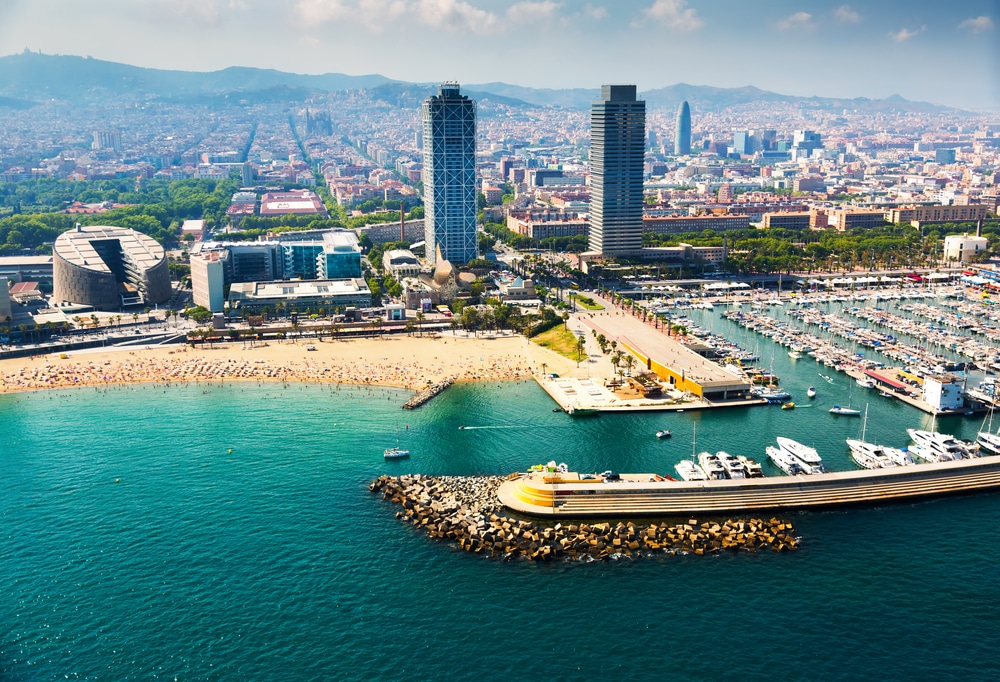The vital capital of the Catalans is one of the oldest and most modern cities in Spain. Barcelona is a city that never stands still. Life pulsates on the streets and alleys – a cosmopolitan city that combines everything. On the one hand, fast-paced and hip, on the other, extremely charming sights. The Barcelonese have their very own rhythm – perfectly adapted to the hot temperatures: siesta at noon and partying until the early hours of the morning at night. Barcelona is a true metropolis with distinct characteristics. It’s all in the mix: The old town around the famous Rambles and the Barri Gótic not only offers all kinds of entertainment, but also satisfies the penchant for romance and nostalgia. Visitors go into raptures, and not only because of the exciting buildings. 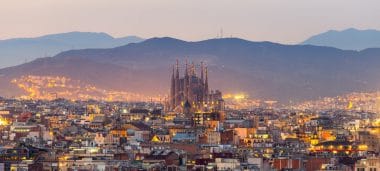
basiczto / shutterstock
A journey through Barcelona’s charming neighbourhoods
In no other district are so many museums and monumental buildings close together as in Barri Gótic. The elevated and oldest district of Barcelona is overwhelming: The Gothic Quarter is home to La Seu – the Cathedral of Barcelona, the Roman cemetery of the 1st to 3rd centuries, the Museum of the History of the City and the Museu Frederic Marés, as well as an erotic museum and a maritime museum. The magnificent boulevard Ramblade Raval also runs along here. Spain’s most famous promenade is filled with life day and night. At the end of the harbour side is the Columbus statue. The boulevard stretches from Plaça de Catalunya (the most central square in Spain) to the Port Vell port with the Columbus statue. Good to know: Barcelona is Europe’s capital of pickpockets! In addition: In the summer months, you can watch dancers in front of the cathedral shaking hands in a circle. In front of the impressive cathedral, it is customary to dance sardana. Folk dance is an important part of the culture and a symbol of Catalan pride.
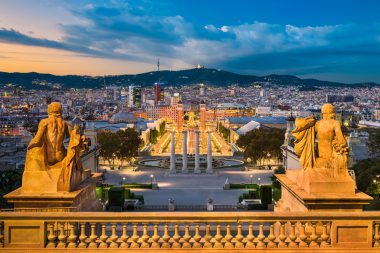
Barcelona and the sea
In the past, it was said that Barcelona has its back to the sea. Scrapped industrial sheds blocked the view. In 1992, with the Olympic Games, they opened up. Sculptures, parks and idyllic squares with comfortable benches act as a legacy of the Olympic renewal frenzy. On one side of the harbour the image of Columbus shines and opposite the “W” Hotel inspires as another milestone. The man-made Barceloneta beach is 4.2 kilometers long. It’s worth having a drink in the cosy Bar Marsella, Barcelona’s oldest bar – once the second home of Ernest Hemingway. 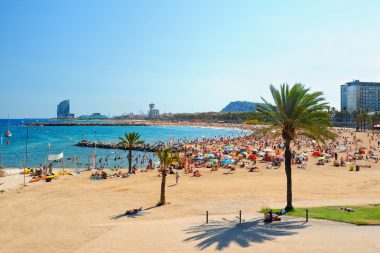
Fountain magic, fairytale roofscape and gigantic dimensions
In front of the National Palace, visitors enjoy an extraordinary spectacle. This is where the magic fountain unfolds its incredible effect. Impressive water fountains, accompanied by classical music, offer a fascinating fountain show. A goosebumps moment that you won’t forget in a hurry. The “Font Magica” inspires every Thursday to Sunday from 9 p.m. Casa Milá in the new town of Elixample: With this building, Antoni Gaudi defied all conventions. This building with the bizarre roofscape is a completely “normal” residential building. The building, which the locals call La Pedrera (quarry) with little reverence, has been declared a World Heritage Site by UNESCO. It must not only be admired from the outside. 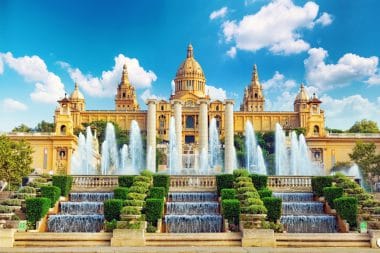
Mega touristy, but a must – the biggest construction site in Barcelona:
Standing in line for hours, quite high entrance fees, loud and lively – Sagrada Familia – everyone wants to go! A land turtle and a water turtle watch over the building. They stand for the two worlds and support the entire building. The foundation stone for Gaudi’s masterpiece was laid in 1882. You can take the elevator in the tower of the Passion façade at a height of 65 meters and watch the construction work. Despite the many tourists, it is a sublime feeling to linger in the halls that have not yet been completed. Sagrada Familia is undoubtedly a gigantic sacred building and unique: even after the death of the architect, there is no standstill. His unfinished life’s work has been built for years with donations. Completion of the Sagrada Familia is scheduled for 2026.
Relaxation and culinary highlights
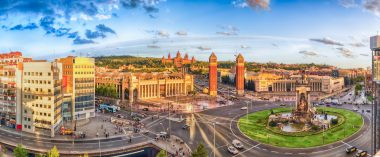
Barcelona: The 7 most important sights
Barcelona, the vibrant capital of Catalonia, is a melting pot of art, culture, and history.
The city inspires with its unique architecture, lively streets and an incomparable atmosphere.
Here are the seven must-see sights on your visit to Barcelona.
1. Sagrada Família
The Sagrada Família, the unfinished masterpiece of Antoni Gaudí, is one of Barcelona’s most recognizable landmarks.
This stunning basilica combines Gothic and Art Nouveau styles in a unique structure that dominates the city skyline.
2. Park Güell
Park Güell is another Gaudí masterpiece and a UNESCO World Heritage Site.
The colorful park offers a mix of architecture, nature, and breathtaking views of Barcelona.
3. La Rambla
La Rambla is the most famous street in Barcelona and attracts tourists and locals alike.
The wide, tree-lined promenade is lined with shops, restaurants, and street performers, and runs from Plaça de Catalunya to the harbor.
4. Casa Batlló
Casa Batlló is another remarkable work by Gaudí and an iconic example of the Modernisme style.
The building captivates with its undulating façade, colorful mosaics and unusual architectural details.
5. La Boqueria
La Boqueria, officially Mercat de Sant Josep de la Boqueria, is a lively market and one of the most famous markets in Europe.
Here you will find fresh food, local delicacies and a variety of culinary delights.
6. Museu Picasso
The Museu Picasso in Barcelona houses one of the most extensive collections of Pablo Picasso’s works and offers a deep insight into the artist’s development.
Housed in five medieval palaces, the museum is a must-see for art lovers.
7. Montjuïc
Montjuïc is a hill that offers great panoramic views over Barcelona.
Montjuïc is home to several attractions, including Montjuïc Castle, the Magic Fountain of Montjuïc, and the Museu Nacional d’Art de Catalunya.
The 3 most important museums in Barcelona
1. Museu Picasso
The Museu Picasso houses one of the largest collections of works by Pablo Picasso.
The collection comprises over 4,000 works and provides a comprehensive insight into the artist’s work. Address: Carrer de Montcada, 15-23, 08003 Barcelona, Spain Opening hours: Tuesday – Sunday 9:00 a.m. – 8:30 p.m. Admission: 12 EUR
2. Museu Nacional d’Art de Catalunya (MNAC)
The MNAC on Montjuïc houses one of the most comprehensive collections of Catalan art from the Middle Ages to the 20th century.
Of particular note are the Romanesque frescoes and the works of Catalan modernism. Address: Palau Nacional, Parc de Montjuïc, s/n, 08038 Barcelona, Spain Opening hours: Tuesday – Saturday 10:00 am – 6:00 pm, Sunday 10:00 am – 3:00 pm Admission: 12 EUR
3. Fundació Joan Miró
The Fundació Joan Miró is a museum dedicated to the work of the famous Catalan artist Joan Miró.
The museum displays an impressive collection of paintings, sculptures and drawings. Address: Parc de Montjuïc, s/n, 08038 Barcelona, Spain Opening hours: Tuesday – Saturday 10:00 am – 6:00 pm, Sunday 10:00 am – 3:00 pm Admission: 13 EUR
Where to stay in Barcelona
Luxury Hotel: Hotel Arts Barcelona
The Hotel Arts Barcelona is a luxurious 5-star hotel located on the beach in Barceloneta.
It offers modern rooms, an exclusive spa and several first-class restaurants. Address: Carrer de la Marina, 19-21, 08005 Barcelona, Spain
4-star hotel: Room Mate Anna
Located in the heart of Barcelona, Room Mate Anna offers stylish rooms, a modern design and a rooftop terrace with a pool and views of the city. Address: Carrer de Pau Claris, 101, 08009 Barcelona, Spain
3-star hotel: Hotel Jazz
Located just a few steps from Plaza Catalunya, Hotel Jazz offers comfortable rooms, a rooftop pool and a relaxed atmosphere. Address: Carrer de Pelai, 3, 08001 Barcelona, Spain
Budget Hotel: Hotel Ronda House
Hotel Ronda House offers simple but comfortable accommodation in a central location.
It is ideal for travelers on a budget who want to explore the city. Address: Carrer de Sant Erasme, 19, 08001 Barcelona, Spain
Popular Restaurants in Barcelona
1. Can Culleretes
Can Culleretes is one of the oldest restaurants in Barcelona and is known for its traditional Catalan cuisine.
It offers a cozy atmosphere and delicious, homemade dishes. Address: Carrer d’en Quintana, 5, 08002 Barcelona, Spain
2. Tickets
Tickets is an innovative tapas restaurant run by the Adrià brothers.
It offers creative dishes and a unique culinary experience. Address: Av.
del Paral·lel, 164, 08015 Barcelona, Spain
3. Bar Pinotxo
Bar Pinotxo is an iconic tapas bar in the Mercat de la Boqueria and is known for its tasty small plates and friendly atmosphere. Address: La Rambla, 91, 08002 Barcelona, Spain
4. Cervecería Catalana
Cervecería Catalana is a popular tapas bar in Barcelona, known for its wide variety of tapas and lively atmosphere.
It is the perfect place to taste local specialties. Address: Carrer de Mallorca, 236, 08008 Barcelona, Spain
FAQ: Important questions about Barcelona
What is the best way to get to Barcelona?
Barcelona is easily accessible by plane.
Barcelona-El Prat Airport (BCN) is located about 15 km southwest of the city.
From there, you can get to the city centre by train, bus or taxi.
When is the best time to visit Barcelona?
The best time to visit Barcelona is from May to June and from September to October, when the weather is pleasant and the city is not crowded.
What are typical souvenirs from Barcelona?
Typical souvenirs from Barcelona include Catalan ceramics, cava (Spanish sparkling wine), Spanish olive oils and handmade jewellery.
Bibliography
- Information about monuments and museums: Barcelona Turisme
Article updated on August 21, 2024


